
| Volume 21, Issue 1 | January 21, 2019 |
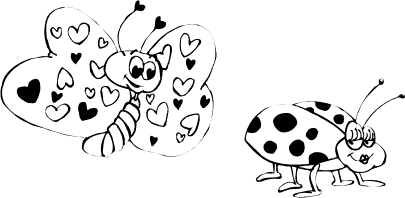
|
In this Issue:
|

| Volume 21, Issue 1 | January 21, 2019 |

|
In this Issue:
|
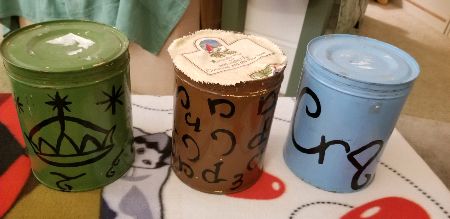 Sisterhood of the Traveling Tins. Curtis has always been into Tolkien, and into painting miniatures. For Christmas 1979, a year after Jeanine and Curtis got married, Curtis painted up some tins with Tolkien runes, and sent our gifts to Julia in them. Julia sent them back with Texas pecans, and a tradition was born. We sent them back and forth to each other until the last time, Christmas 2016. Family members remember those cans, and helping Julia fill them. |
I remember, though, the time Julia sent me on a Boy Scouts river adventure with Jeanine's youngest brothers. (More is written about this elsewhere.). Most of my memories start from the yearly visits she would make to our home after I left Austin. I would be the gourmet cook, waiter, drink maker,
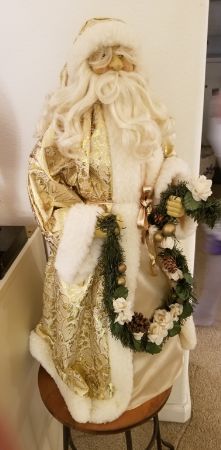 In 1998, Julia bought us this Santa for our house. It was brilliant! We have a specific place for this Santa every year. |
Julia had never been to Europe, so, in the summer of 1987, I got her first class tickets to Paris and a week in a five star hotel, Prince De Galles, on avenue Georges 5th, in downtown Paris. Julia had a great time there with Jeanine (her interpreter). The three of us had a great dinner on the Champs Elysees. Julia and Jeanine would often go on traveling adventures.
Julia and Jeanine had Sunday telephone calls almost every week, and I often would get on the phone to discuss the latest goings on.
Curtis
Dec. 31, 2018
(Thanks much, Curtis, for your remembrance of Julia, 10/16/22-11/18/18, who was Larry's, Jeanine's, and their six brothers' mom. Larry)
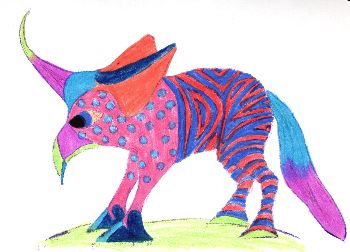 1970: drawing for a coloring book (somebody else colored this one - yikes!)  about 1973: I had discovered how to draw "glass drops" 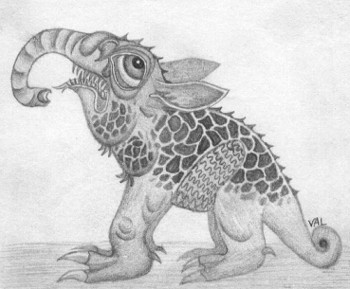 about 1975: playing around with expressive eyes |
While pondering the pros and cons of imagination vs. rational observation, I of course think back to what I did, and what I liked or did not like when I was a kid. At least I try. The passage of over 50 years gives me serious pause about my ability to accurately recall anything from that period. I do, however, have a few solid pieces of evidence that reflect my behaviors from the ancient past. Photos, some written essays, report cards, and a few other mementos have been preserved, mostly due to the exceptional organizational skills of my mother. I also have a fair amount of my artwork, especially that produced after about age 11 when my whole "portfolio" (a large envelope containing most of my drawings) was demolished by my dog. At this point I can only hope that she enjoyed the experience as much as I lamented it. I can still remember the sinking feeling of finding shreds of paper all over the floor.
Anyway, from that time on, I was a bit more careful when it came to storing my artwork and I now have quite a compilation. Besides drawing familiar animals and plants, or copying images I found in books, I sometimes just made up creatures. They could be mythical, such as unicorns and dragons, or chimeric, or almost abstract. I doodled on my notebook covers in school, letting one form morph into another until I'd filled all the space available. Drawing was something of a time-waster, but it also could be a bit useful. I contributed images for the school bulletin board, illustrated my homework, or created posters and cards. Sometime around age 8 or 9, I started drawing a composite creature that had a large head, such as an elephant or giant parrot, a horse-type body and a long tail. The details varied with each iteration; sometimes the head had a beak, a trunk, large ears or a single horn on the head. Sometimes the body had spots, stripes, scales or even wings. I liked to add some sort of decoration down the spine, such as the osteoderms or scutes on reptiles. The legs might end in horse hooves or bird claws or something similar to suction cups. The tail ranged from that of a horse to a snake to a possum to a dinosaur. It was easy to see that some influences were real animals while some were imaginary monsters. I never gave the creature a name, but I was aware that I was just fooling around with the design on a single type of beast. It was fun - kind of like daydreaming realized.
I returned to this theme a couple of times during the ensuing years, but in my twenties, more of my artwork was purposeful (I needed to earn money), especially the production of posters for concerts and events, so I focused my efforts on practical images and reduced the amount of recreational drawing I did. But once I left school for full-time teaching and performing, the urge to draw for sheer pleasure returned.
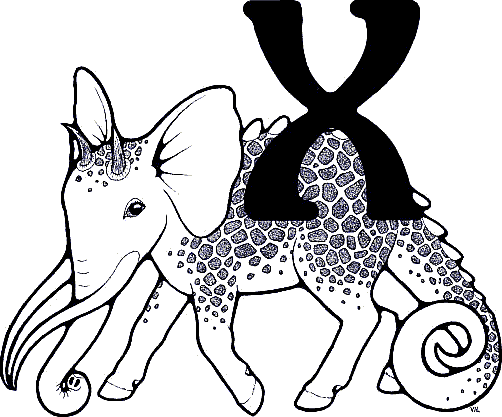 The Xenozoan |
It's funny how a figment of my imagination seems as familiar as any real species of animal. I've known it for decades, and the Xenozoan sort of evolved as I aged, its various composite bits changing as I experimented with the different visual effects. I tended to strive for a biologically convincing look, as if such a creature could in fact live in an alternate reality. I find actual animals, in all their diversity and glory, to be incredibly engaging, but I also enjoy a romp in the creative universe of the imagination as well. It would be impossible to relinquish either, and I am glad that, as a child, I was privy to both the factual and the fantastic.
| Our lens focuses for this issue on one of the "out-take" images from a series of studio photos of Larry's dad, Leon, and his mom, Julia, on the eve of their February, 1992, 50th wedding anniversary. The official picture they had chosen to share with family for that milestone was fine as well, but just a little more solemn. Thanks much to two of Larry's nieces for locating and/or making easily available this more jocular bit of his folks' marital history. Some find it an even better choice. February 3, 2019, would mark 77 years since their 1942 wedding. |
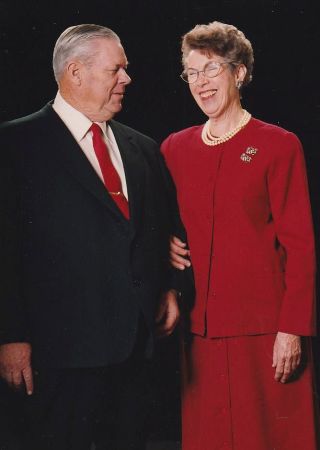
|
![]()
| (The Terra Tabloid is a venue for the discussion of issues pertaining to the past, present, and future of our planet and human interaction with it.) |
The idea of an independent or second genesis for the emergence of life comes from the notion that, whether consistent with Genesis as described in the Bible or an evolutionary origin of life on Earth, to date we know of only one planet where this phenomenon has occurred. Yet what if extraterrestrial life were found? It would be a discovery of staggering implications. We have been thinking of animate forms in all their variety as strictly Earth-based. Yet obviously if it could develop elsewhere it might arise almost anywhere the conditions were right. Life would no longer be unique to our particular planet. There are estimated to be trillions of worlds in the universe. How likely is it that in all those spheres ours is the only one with life? At this time we may still sort of toot our own horns as being really special. Maybe we are, or maybe not so much. Perhaps one simply needs to look in places that have things in common with our own early Earth to have a decent chance of discovering more "alien" life. Probably it would not look or act like us, but that it is alive and hanging out elsewhere would be sufficient to demonstrate we no longer are quite so extraordinary. For our egos, it might be a healthy reality check.
Most people are familiar with SETI, the Search for Extraterrestrial Intelligence. Many years of effort and over a billion dollars have so far been expended in this quest to find both an independent origin of life and smart beings elsewhere in the universe. Yet, notwithstanding the dramatic hype behind it, SETI is unlikely to discover life from other planets in the foreseeable future. Space is just too vast, and the odds of a bright species wanting to communicate with us or sending out signals inadvertently that we could detect in a reasonable period within a span of time as short as a few decades would appear remote. For one thing, it takes many years, decades, or even hundreds or thousands of years for light to merely travel between potential intelligent sources of radio waves and our receivers on Earth. Were we to ever take note of messages from aliens on other worlds, we would then need a little while to decide on if and how we would respond. Messages going back, then, would take equally long to finally be received by the off-world species. Unlike the instantaneous ubiquity today of texts or e-mails, these new communications, conceivably the most momentous ever for our kind, might require so much time between sending and receiving in each direction that whole civilizations might rise and fall in the interim. If global warming becomes as horrendous for us as many now anticipate, there might well no longer be a SETI staff to "hear" the return message when one at last arrives.
Of course, there is a small chance SETI will be successful. Perhaps another species is looking for us too. To find us in the near infinity of the cosmos might be far more difficult than to spy a proverbial needle in the haystack. However, the chances are at least greater than zero. And if the beings thus contacted follow-up with a visit, such an encounter may not be as wonderful as some imagine. Native Americans might, if they could, prefer to have avoided the results of their first interactions with the then technologically advanced Europeans, after which their numbers were reduced by 80-90% and their cultures forever a shadow of what they had been. Stephen Hawking suggested we might not come off too well in a meeting with those who may be millions of years ahead of us. Is it wise to be advertising our whereabouts? Chances are, though, any beings capable of traversing the distances involved would not bother with or care about us, any more than we would likely enjoy sitting down to tea with lemurs.
 An artist conception of the early Earth setting for first life (sciencenews.org) |
Finally, there are remote investigations of distant worlds via the analysis of data NASA and other space agencies with their telescopes and spectrometers can obtain for interpretation here on Earth. For example, certain kinds of early life on our planet were responsible for almost all of the oxygen now in our atmosphere, without which, naturally, we ourselves would not be living, breathing, and producing many new generations of Homo sapiens. If the chemical signature of large quantities of atmospheric oxygen can be found on distant worlds, we can deduce that living things might have evolved there too. In fact, one world, about 100 light-years away, has been discovered that has oxygen in its atmosphere. Much more research is required and with better telescopes and spectrometry to get practical information along these lines. Another avenue of potential investigation is toward finding other worlds with seasonal changes in the amount of atmospheric oxygen.
How far are our scientists and engineers away from confirming life elsewhere by one or more of the above methods? Who can say? Yet the possibility is there for such a startling development within my lifetime, so I am hopeful of its occurring in these next few years.
And even if life elsewhere were never discovered, the pursuit of it would not be in vain. Who knows what else may be found in the process of that search? In failing to locate a new way to India, Columbus discovered the entire Western Hemisphere. Moreover, as a species we crucially need a more cosmic perspective. Think how different things felt after we could see Earth images captured from the Moon's surface. If we remain divided among our sundry nationalisms, regionalisms, party affiliations, races, religious fragmentations, classes, cultures, or sects, the future is bleak. We can be an amazingly brilliant and generous type of being if we "boldly go where no man [or woman] has gone before." On the other hand, if we persist in seeing merely our particular tribes as worthy and in demonizing those we perceive to be "other," the future holds only catastrophe.
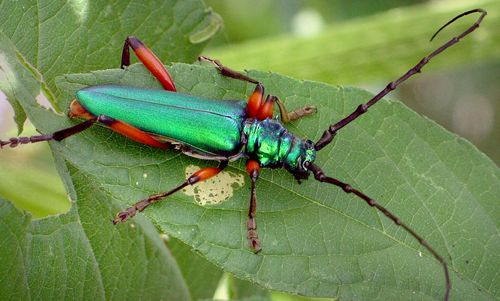
So many insects are tiny and cryptic that finding a spectacular example such as the bumelia borer (Plinthocoelium suaveolens) can be a bit startling. This longhorn beetle is often about 1.5 inches long, with even longer antennae (that's where the "longhorn" name comes from). The metallic body color can be green or bluish, sometimes with reddish highlights, but it always contrasts with the red and black legs.
The larvae, known as round-headed borers, feed on the wood, drilling through trunks and roots of several kinds of trees: tupelo, bumelia, and mulberry. Adults are usually seen in the spring as they feed on flower nectar or hang out near the larval host plants. For such large insects, these beetles fly well and are quick to zoom off if they feel threatened.
Value investing pioneer Benjamin Graham suggested that reasonable total returns may be had from the purchase of assets selling for less than their per share net asset values. Because of their greater risk, for individual stocks one might want a higher margin of safety, for instance ones selling for no more than two-thirds of their appraisal after subtracting all debt. Overall, however, closed-end funds are less subject to loss of principal and so when selling for simply lower than their average discount to net asset value they tend to be good investments. Exceptions can be ones that use a lot of leverage, holding stocks bought with significant amounts of debt.
A closed-end fund (or CEF) is merely a kind of mutual fund offering the investor a pool of investments under management, as with open-end funds, yet with a fixed number of shares, so prices per share rise and fall depending on demand, as with shares of common stocks. Market forces, then, can result in both premiums and discounts relative to net asset value. Graham would have wanted to sell holdings which had achieved significant price premiums over their real values, while, everything else being equal, finding attractive CEFs that were sporting large discounts. Here would be fruitful stalking grounds for the bargain hunter.
For a long-term, income oriented investor, an interesting benefit of buying CEFs is that their dividends (if any) are higher, relative to share cost, when there is a substantial discount to net asset value. A CEF that offers a 3.00% annual yield, for instance, actually pays the investor who buys shares at a 20% discount 3.75% a year in dividends. (In this example, an investor with $10,000 [after a commission] can buy $12,500 worth of net asset value in a CEF that has a 20% discount [for .8 times $12,500 = $10,000, and a 3.00% dividend on $12,500 = $375 or 3.75% of $10,000].
Since the market as a whole is significantly lower than a few months ago, we might expect now to find a few closed-end funds that offer nice discounts. In fact, comparing market prices with net asset values, the six assets in the table are all found to have discounts of 10% or more and appear promising as investments at current levels.
| Fund | Ticker Symbol | Recent Price | Discount |
|---|---|---|---|
| Central and Europe Fund, Inc. | CEE | $23.70 | 14.17% |
| Japan Smaller Capitalization Fund | JOF | $8.60 | 14.67% |
| Mexico Fund | MXF | $14.19 | 13.57% |
| Source Capital, Inc. | SOR | $33.69 | 13.55% |
| Templeton Emerging Markets Fund, Inc. | EMF | $13.80 | 10.93% |
Since each of these CEFs is now available at a better than average discount to net asset value, in my view the group as a whole has an excellent chance of attaining higher than usual total returns over the next few years, thus for the patient investor potentially doubling one's investments by around 2025, whereas their collective total return has averaged 9.10% a year for the previous decade (a price gain plus dividends rate that normally would see them double in about 8 years).
Making selections such as in the above table is of course but a first step in deciding on securities that are appropriate for one's own portfolio. An investor is best served determining his or her overall goals of investing, then with what level of risk he or she is comfortable, and what strategy seems best to achieve desired ends. Closed-end funds such as these may fit into one's approach and, if so, might be looked at in terms of growth, income, safety, and underlying value.
Good luck in your own investment decisions and in sticking with a successful long-term plan for achieving rewarding money management goals.
| |||||||||
|
We had ideal viewing conditions here in central Texas for the spectacular total lunar eclipse last night. Here's hoping all your holidays over the next month: MLK Day, Groundhog Day, Valentine's Day, and Presidents Day, are meaningful, festive and more pleasing than not.
|
| For others who may have chanced upon this site, larvalbug bytes is a monthly family-and-investment newsletter, put out by an old codger and sweet thing, with sometimes a little help as well from our engaging pooch, Peri. We invite readers' comments by and would also be happy to readers when new issues are published. Articles and stories from back issues are available in our archives. |

|
Copyright © 2019 by LARVALBUG
"Bugs In Love" (based on a free font by Manfred Klein) and larvalbug web design by Valerie.
![]()